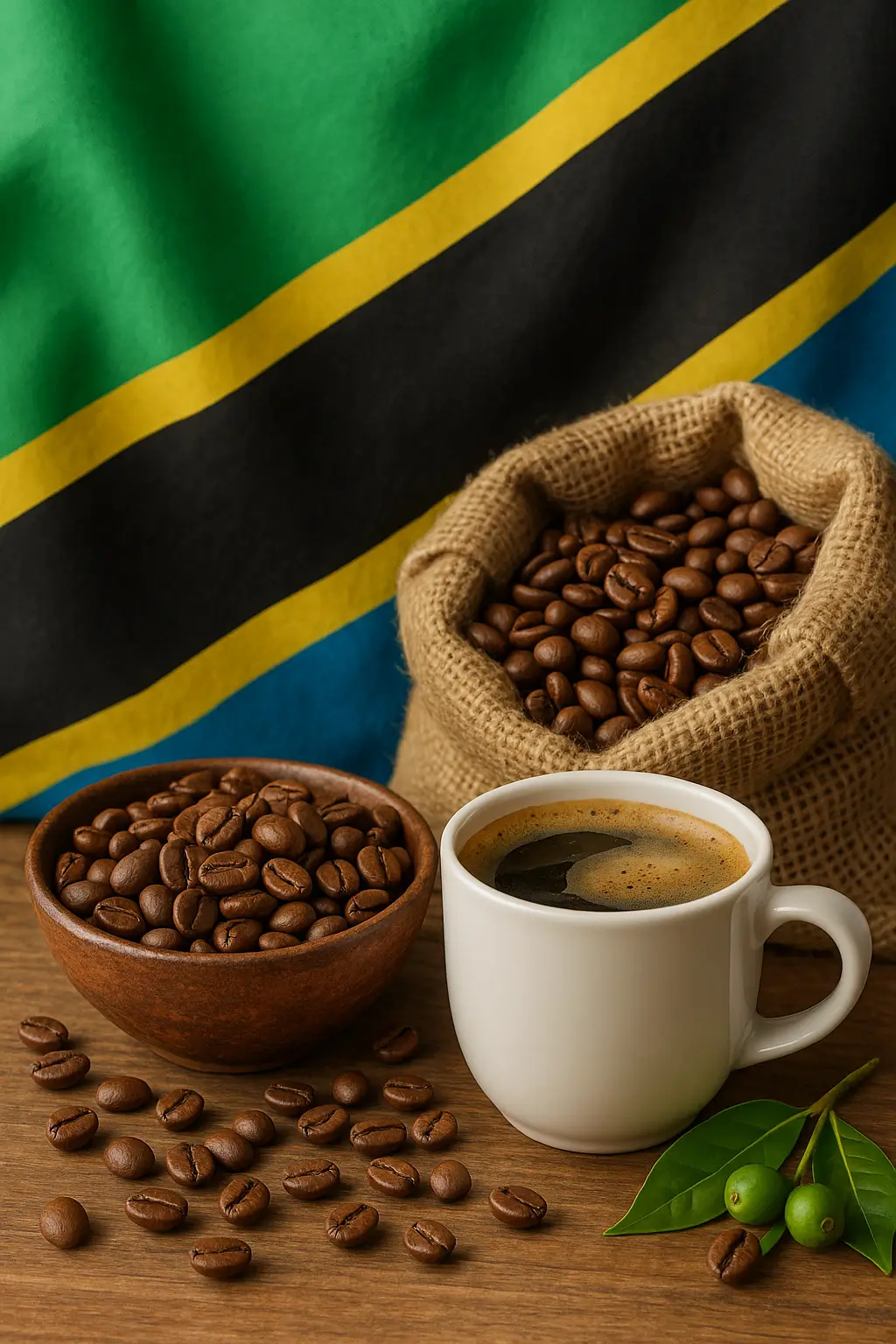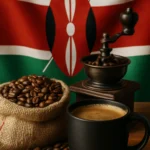Tanzanian coffee is a prized specialty from the heart of East Africa. This brew offers a unique, balanced flavor. You will find bright, gentle acidity, vibrant fruit, and sweet chocolate notes. Its distinct complexity boosts its global market appeal. High-altitude farms and nutrient-rich volcanic soils shape its unique taste. Tanzanian coffee consistently delivers a nuanced cup.
- What is the signature flavor profile of Tanzanian coffee?
- How do Tanzanian coffee regions influence their unique flavors?
- Where are the key Tanzanian coffee regions located?
- What types of coffee beans are grown in Tanzania?
- What processing methods are used for Tanzanian coffee?
- How does Tanzanian coffee compare to other East African coffees?
- What is the rich history and economic significance of Tanzanian coffee?
- Why should you explore Tanzanian coffee?
What is the signature flavor profile of Tanzanian coffee?
The signature Tanzanian coffee flavor profile balances bright fruity acidity, sweet chocolate tones, and mellow, lively aromas. Fertile volcanic soils and high-altitude growing conditions create this unique combination. Its acidity is bright and vibrant, but gentler. It is less sharp than, for instance, Kenyan coffee. Many describe it as ‘wine-like’.
Prominent fruity notes often include:
- black fruits,
- red fruits,
- various citrus elements like lemon and mandarin,
- black cherry, pineapple, or passion fruit, contributing to a general berry-like sweetness.
Tanzanian Peaberry beans are single, round beans. Many think they concentrate flavors, enhancing these fruity nuances. Complementing the fruit, you will often find rich, sweet undertones. These can include:
- chocolate,
- vanilla,
- praline,
- caramel,
- molasses.
The coffee typically has a medium to full body. It delivers a creamy, intense, velvety, or silky mouthfeel. The dry aroma of ground Tanzanian coffee can range from rustic or brown bread sweetness to delicate floral notes, or even a distinct molasses fragrance. The roasting process significantly influences these flavors. Lighter roasts emphasize herbal-floral notes and brightness. Darker roasts enhance berry fruits and introduce spicy black pepper accents.
How do Tanzanian coffee regions influence their unique flavors?
Different Tanzanian coffee regions give the beans distinct flavor nuances. This happens because of their unique terroir. Specific microclimates and soil compositions shape the cup’s final characteristics. For instance, coffee from the Kilimanjaro region consistently features prominent black fruits, red fruits, and a zesty lemon note. It also carries sweet undertones of chocolate, vanilla, and praline, all underpinned by a distinct acidity and a smooth, velvety mouthfeel.
Coffees from the Southern Highlands region, which includes Mbeya and Ruvuma, often present notes of black cherry and mandarin. These blend with richer, sweeter tones of chocolate, molasses, and caramel. This leads to a silky body and a mild acidity. In contrast, Robusta coffee from the Western Lakes region, particularly around Kagera, offers citrus flavors with hints of caramel. Darker roasts of this coffee develop chocolate and spice notes. It exhibits a lively yet mild acidity, making it suitable for espresso blends.
Where are the key Tanzanian coffee regions located?
Key Tanzanian coffee regions concentrate in two main highland areas: Northern Tanzania and Southern Tanzania. Each region offers unique conditions. These conditions profoundly contribute to the beans’ distinct quality and flavor. Northern Tanzania includes major coffee-growing districts like Arusha and Moshi. These lie on Mount Kilimanjaro’s fertile slopes.
The Pare high plateau is also a significant area in this northern zone. Here, coffee cultivation primarily features Arabica coffee. It grows at high elevations, typically between 1,250 and 1,400 meters above sea level. This earns it the designation of Strictly High Grown (SHG). These northern areas benefit from a cooler climate, abundant rainfall, and rich volcanic soils. Farmers often intercrop coffee trees with banana trees. This provides natural shade and helps with erosion control.
International buyers often prefer coffees from these northern regions for their distinctive taste and aroma. Southern Tanzania includes regions like Mbeya, Mbinga, Ruvuma (Songea), and Songwe. This area extends between Lake Nyasa and Lake Tanganyika. This area also primarily grows Arabica coffee at high altitudes. While the soil here might have slightly fewer minerals than in the north, the southern climate offers excellent drying conditions and better transport access. This minimizes defects during transit.
The coffee produced in Southern Tanzania has a distinct taste profile. This differentiates it from northern coffees due to variations in soil composition and drying processes. Additionally, the Kagera region in northwest Tanzania, particularly Kyerwa and Karagwe near Lake Victoria, is a notable area for Robusta coffee cultivation. Minor Arabica regions include Iringa, Kigoma, Matengo Highlands, Morogoro, Ngara, and the Usambara Mountains. These further diversify Tanzania’s coffee landscape.
What types of coffee beans are grown in Tanzania?
Tanzania mainly grows Arabica and Robusta beans. Arabica makes up about 70% of total production, while Robusta accounts for the remaining 30%. For Arabica, several prominent varietals thrive across Tanzania’s diverse coffee regions. These include well-known types like Bourbon, Kent, and Typica. Locally, people often call Typica “Nyara”. The prized Blue Mountain varietal also grows here, along with Nyassa and N39. These are specifically adapted to local conditions.
- Bourbon,
- Kent,
- Typica (Nyara),
- Blue Mountain,
- Nyassa,
- N39.
The Tanzania Coffee Research Institute (TaCRI) actively develops and promotes new experimental Arabica varieties. These include SC 3, SC 11, SC 14, SC 9, and KP 423. They aim to improve yields and disease resistance. Robusta coffee primarily grows in the northwestern Kagera region, specifically in areas like Kyerwa and Karagwe near Lake Victoria. Historically, the “amwani” variety of Robusta has been significant in this region.
What processing methods are used for Tanzanian coffee?
The primary Tanzanian coffee processing methods are wet processing and dry processing. Each impacts the final flavor significantly. The method chosen largely depends on the coffee species and regional practices. Wet processing, also known as the washed method, is the dominant technique for Arabica coffee. This is especially true for high-quality beans like Tanzanian Peaberry. This meticulous method involves several steps:
- Farmers first sort ripe cherries to remove defects.
- They then pulp the cherries to remove the outer skin.
- The coffee seeds ferment, typically for 12 to 48 hours, to break down the sticky mucilage layer.
- After fermentation, the beans wash thoroughly.
- Finally, the beans sun-dry, usually on raised beds, until their moisture content reaches 10-12%.
This method consistently yields coffee with bright acidity and exceptionally clean flavor notes. In contrast, dry processing, or the natural method, is more common for Robusta coffee. With this method, entire coffee cherries spread on raised beds and sun-dry. This requires regular turning to prevent mold or uneven fermentation. Once the cherries are sufficiently dry, mechanical processes remove the dried skin and pulp from the beans. This method uses less water and generally costs less to implement.
A third, less common method is the Home Processed (HP) method. Some smallholder farmers use hand pulpers for this. While it gives farmers greater control, this method can lead to variable quality. This is due to inconsistent fermentation timing and control. Sometimes it results in undesirable “foxy beans” defects. Overall, careful processing of Tanzanian coffee is crucial for developing its distinct characteristics.
How does Tanzanian coffee compare to other East African coffees?
Tanzanian coffee has a distinct profile. It holds a unique position among its prominent East African neighbors, Kenyan Coffee and Ethiopian Coffee. All three have a reputation for high quality. However, their individual characteristics show notable differences in flavor and body. Here’s how they compare:
| Trait | Tanzanian Coffee | Kenyan Coffee | Ethiopian Coffee |
|---|---|---|---|
| Acidity | Gentler, mellow, often “wine-like” | Bright, vibrant, sometimes sharp | Bright, floral, distinctly citrusy |
| Fruit Notes | Black fruits, red fruits, black cherry, tangerine | Pronounced blackcurrant, strong citrus, various berries | Delicate citrus, floral notes (jasmine, bergamot) |
| Body/Mouthfeel | Smooth, velvety, or silky | Medium to full, often juicy | Lighter to medium, more delicate |
| Sweet Undertones | Chocolate, caramel often prominent | Less prominent compared to Tanzania | Less prominent compared to Tanzania |
Sweet undertones of chocolate and caramel are generally more prominent in Tanzanian coffee. While all three produce excellent coffees, Kenyan coffee often sets a benchmark for consistency and high quality. Ethiopian coffee is celebrated for its complex, diverse range of profiles. All three nations predominantly use the washed processing method, though Ethiopia also widely uses the natural method.
What is the rich history and economic significance of Tanzanian coffee?
Tanzanian coffee production history spans centuries, long before its commercialization. In the 16th century, the indigenous Haya tribe in northwest Tanzania used a specific Robusta variety called “amwani.” They used it as currency and a stimulant, not as a brewed drink. Formal cultivation for export began during German colonization in the late 1800s and early 1900s.
The German administration actively promoted Arabica coffee plantations. This significantly boosted exports between 1905 and 1912. After World War I, British colonial rule continued and expanded these coffee cultivation efforts. There were no major disruptions to the established infrastructure.
Post-independence, especially in the 1960s, Tanzania’s socialist government worked to boost coffee production nationwide. This led to a significant expansion of cultivation southward. Regions like Mbeya and Ruvuma grew in prominence. Today, an impressive 75-85% of Tanzania’s coffee output comes from these southern regions. Historically, Moshi in the north served as a central coffee milling hub during the 1950s and 1960s. It played a crucial role in processing the country’s coffee beans.
Economically, Tanzanian coffee remains one of the country’s largest export crops. It provides a vital livelihood for over 320,000 smallholder farming households. These households collectively account for about 95% of the national output. While it represents about 0.7% of the global coffee trade, its contribution to local economies and rural employment is immense. This makes it an indispensable part of Tanzania’s agricultural landscape.
Why should you explore Tanzanian coffee?
Tanzanian coffee offers a truly unique and compelling experience for coffee lovers. Its distinct flavor profile sets it apart in the global specialty coffee market. You will find a complex balance of bright fruity acidity, sweet chocolate tones, and mellow, lively aromatics. The diverse regional profiles offer a range of fascinating options. These range from the bold fruits of Kilimanjaro to the silky sweetness of the Southern Highlands. Beyond its exquisite taste, Tanzanian coffee holds significant cultural and economic importance. It supports hundreds of thousands of smallholder farmers. Exploring Tanzanian coffee means discovering a rich heritage and a remarkable cup. Experience a truly unique East African taste for your next brew.









